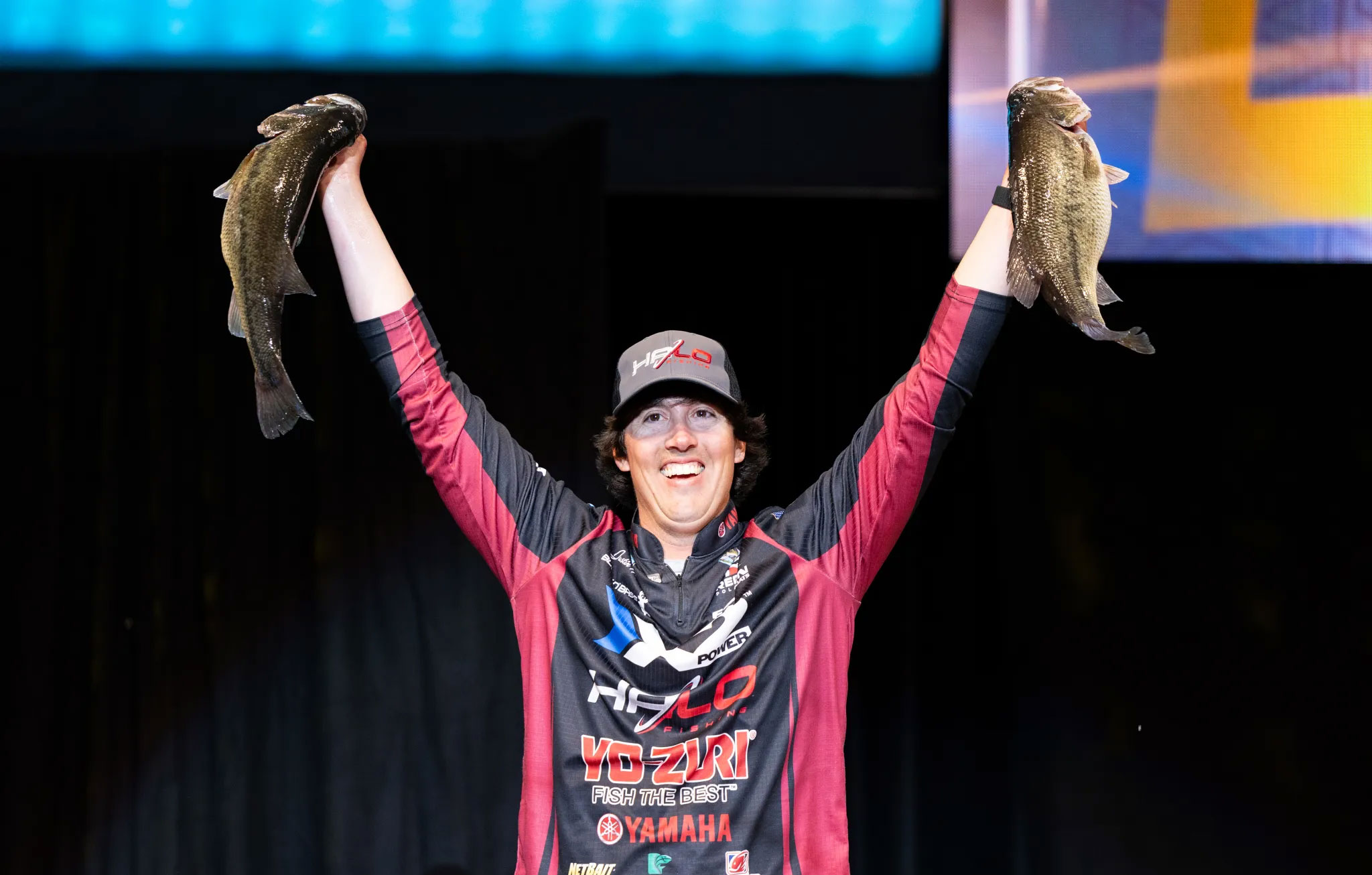We may earn revenue from the products available on this page and participate in affiliate programs. Learn More ›
Alabama native Justin Hamner won the 54th Bassmaster Classic at Grand Lake O’ the Cherokees in Oklahoma primarily using a jerkbait to catch bass around cover he had located with forward facing sonar. The tactics he employed indicate the direction that bass fishing has headed, and not just for tournament anglers.
During the three day event (March 22nd through the 24th), Hamner piled up a cumulative catch of 15 bass weighing 58 pounds, 3 ounces. This was enough to beat out the other 55 competitors and net him a $307,000 payday—as well as a spot in the bass fishing history books.
An avid jerkbait fisherman as well as an electronics aficionado, the 33-year-old Bassmaster Elite Series Pro relied heavily on his strengths to earn him the title. Hamner also credited his win to growing up in Alabama, since its there that he gained critical knowledge and confidence while fishing for pre-spawn bass. Here’s how he caught them, and how you can too.
Using a Jerkbait to Target Pre-Spawn Bass
A jerkbait has long landed near the top of the list when it comes to pre-spawn baits. As bass and baitfish push shallow to spawn after the cold winter months, a jerkbait’s profile paired with its stop-and-go action creates the perfect combination for tempting big bass into biting.
The water is typically still a little cold this time of year, as it was on Grand during the Classic, hovering near or below the 60-degree mark. This is primetime for a jerkbait, as this bite is less fickle compared to other techniques. A sudden spring cold snap can wreck a lot of patterns this time of year, for example shutting down any hint of a topwater bite. A cold snap can also stall out the advancement of spawners.
By and large, the jerkbait is the most reliable lure for this pre-spawn window, as the bass are positioned relatively shallow, often in less than 10 feet of water. The ability to vary the retrieve of a jerkbait is also a critical component of its effectiveness, allowing the angler to fish the bait fast or slow depending on the mood of the fish, while also being able to let it suspend right in the fish’s face on the pause.
Pairing a Jerkbait with FFS
FFS has polarized the sport of bass fishing the last two years. Love it or hate it, being able to see a clear, visual representation of what’s under the water in front of you, and all around you, has completely changed how effective and efficient anglers can be.
Hamner, a phenomenal jerkbait fisherman, is also intimately in tune with his electronics. Using the two together, Hamner was able to locate large bass in a variety of locations around an assortment of different cover types including brush piles, shallow laydowns, and bluff walls.
He used his Garmin LiveScope to locate cover, as well as individual bass at times. Once he spotted the target, his long-cultivated instincts took over and muscle memory kicked in. Knowing how to convert in his mind the blobs, marks, and lines on his graph into real-world feet and inches allowed Hamner to make perfect casts, which was imperative to his success.
Hamner was also able to monitor the effectiveness of his cast by watching the bait and the bass on the screen, often using irregular pauses and pumps of his lure to trigger the dipping and darting bass into committing to his bait.
How to Adjust with the Conditions
Being able to catch bass using a jerkbait during the pre-spawn isn’t a perfect science or a simple task. Being able to do so over multiple days is far from guaranteed. However the Champ did this to perfection on Grand, as several other anglers who were also fishing jerkbaits (and other lures) failed to maintain the pace we saw from Hamner.
Fluctuating conditions contributed to some tough fishing at Grand. Being able to adjust to changing water levels on rivers and or other flood control fisheries is important in the spring. And seldom do two consecutive days see identical cloud coverage, wind direction, wind speed, or precipitation.
Any and all of these variables can effect the pre-spawn bite, whether you’re throwing a jerkbait or anything else. But when talking jerkbait fishing in particular, you’ll really want to pay close attention to any changes in the water clarity and the cloud coverage, using more natural and translucent patterns in sunny and clear conditions, and more solid and bright patterns in stained-to-muddy water or when heavy cloud cover is present.
Hamner adjusted as the conditions required, alternating between different styles and depths of jerkbaits depending on the type of cover he was fishing around and depending on the depth he wanted to target. But he made even bigger adjustments based on the wind, vacating the area where he caught his 22-pound, 6-ounce bag on Day 1 and relocating to where the wind wasn’t quite as strong. The move resulted in two 5-pound bites and another 20-pound limit on Day 2.
Read Next: These 3 Classic Jerkbaits Are Still the Best for Bass and Trout
Why Wind Matters
Wind can be your friend in the spring, or it can completely wreck an area. It can push bait into a spot, creating a concentration of forage for the bass to gang up on. But even this can be a bad thing, as we saw in Hamner’s case. The wind blew directly into his Day 1 spot on Day 2, and brought with it plenty of bait. But according to the champ, that resulted in the bass completely ignoring his lure as they zeroed in on live forage.
Wind can also muddy up an area if it blows hard in a sustained direction. This can be bad, but anglers can use it to their advantage by targeting concentrated fish along a developing mud line. You can even have a wind current created if there’s a narrow gap between two points. We saw a few anglers take advantage of this exact situation at the Classic.
The more modern negative effects of wind are felt most by anglers who are trying to use (FFS) to target bass. Regardless of what has been observed through the camera lens, catching bass using FFS isn’t nearly as easy as it looks most of the time, and it’s made exponentially more difficult as the wind blows the boat around and lifts the bow up and down.
Fighting a stiff and shifting wind with the trolling motor while trying to keep a transducer trained on a bait and a bass at 60 feet is a tall task. This may have had as much to do with Hamner’s inability to effectively fish his starting spot as on Day 2 as anything.
How to Fish Like Hamner
If you’re wanting to target pre-spawn bass with a jerkbait the same way Hamner did on Grand, look for areas where shallow water and deep zones come in contact with one another. A few examples are bluff walls, creek channel swings, and 45-degree banks. Finding brush, laydowns, docks, and boulders in areas like this will help you locate the bass, which often like to position themselves near cover to ambush prey.
See It
A simple pump-pump-pause cadence with a standard-size jerkbait like a Megabass Ito Vision 110 is a great place to start. This bait is a good representation of a jerkbait and it’s one that has caught countless fish for anglers all over the world. This bait or one similar to it will dive down to 4-to-6 feet and suspend on the pause.
Choose your colors based on the conditions, translucents being more effective in high visibility situations and solid, brighter colors working better when visibility is low, due to stain in the water or a lack of sunlight. Pump the bait a couple times and then let it sit for a second or two, lengthen the pause to 5 or 6 seconds if the water is still under 52 degrees in your area.
Twelve-pound-test fluorocarbon spooled on a 7:1 gear ratio reel and a sub-7-foot, medium-heavy jerkbait rod is a good place to start when picking out the rest of your gear.
Read Next: Best Jerkbait Rods
And if you do use this bait in tandem with FFS as Hamner did, you’ll find that over time it gets easier and easier to gauge the direction and length of the cast needed to get your bait to the vicinity of the dot on the screen. Rest easy if you’re not great at this to begin with; Hamner wasn’t either no doubt, not all that long ago. But now he’s the 2024 Bassmaster Classic Champ, thanks to this technique and a determination to perfect it.
Read the full article here




